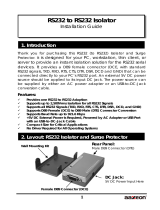Page is loading ...

1
Thank you for purchasing this RS232 (to RS232) Isolator and Surge
Protector. It is designed for your PC, workstation, thin client, or
server to provide an instant isolation solution for the RS232 serial
devices. It provides a DB9 female connector (DCE, with 3-wire signals,
TXD, RXD, and GND) that can be connected directly to your PC’s
RS232 port. An external 5V DC power source should be applied to its
input DC jack. The power source can be supplied by either an AC
power adapter or an USB-to-DC-Jack conversion cable.
Features:
Provides one RS232 to RS232 Adaption
Supports up to 2,500Vrms Isolation for all RS232 Signals
Supports 3 RS232 Signals (TXD, RXD, GND)
Supports DB9 Female (DCE) to DB9 Male (DTE) Connector
Conversion
Supports Baud Rate up to 921.6 Kbps
+5V DC External Power is Required, Powered by AC Adapter or
USB Port with an USB-to-DC-Jack Cable
Compact Size for Critical Applications
No Driver Required for All Operating Systems
RS232 to RS232 Isolator and Surge
Protector
Installation Guide
1. Introduction
2. Layout: RS232 Isolator and Surge Protector
9-pin male DSUB RS232
Connector (to Device)
9-pin female DSUB RS232 Connector
(configured as DCE, from Host)
Mini DC Jack connector
for 5V DC power Input

RS232 Isolator and Surge Protector
2
Since this isolator hardware unit should be powered by the external
power source, please connect the 5V AC power adapter or the
USB-to-Power-DC-Jack Conversion Cable to make sure the unit works
properly. If you are using the USB-to-Power-DC-Jack Cable instead of the
AC adapter, please make sure that the USB port is at Host side (the same
side as the DB9 Female connector), DO NOT connected to the USB port at
the device side (the same side as the DB9 Male connector), otherwise, the
unit won’t work and the DC power was passed though the isolation circuits
so the isolator will not function properly.
1. Use static electricity discharge precautions.
Remove possible static discharge potential from any objects that
the converter may come in contact with before installation. This
can be accomplished by touching a bare metal chassis rail after
you have turned off the power.
4. Installing the Isolator and Surge Portector
3. Accessories
RS232 to RS232 Isolator
and Surge Protector
5V AC Adapter
USB to DC Power
Jack Conversion
Cable

RS232 Isolator and Surge Protector
3
2. Locate an unused RS232 port (with DB9 male connector,
configured as DTE), insert the DB9 female connector of the isolator
on it
3. Installing RS232 cable
Connect the RS232 cable from the Isolator’s DB9 male connector
to the RS232 device.
4. Connect the 5V AC Adapter or USB-to-Power-DC-Jack
Conversion Cable
DB9-Male Pin Assignment:
Connect USB power conversion
cable or DC5V AC adapter to
this DC jack
5. RS232 Mode Male DB9 Pin Assignments and
1 5
6 9
9 Pins Signal
1 NC
2 RXD
3 TXD
4 NC-
5 GND
6 NC
7 NC
8 NC
9 NC
NC = No connection

RS232 Isolator and Surge Protector
4
DB9(Male) to DB9(Male) Wiring
Type
Specifications
Connectors
Number of Ports
RS232 Signals
Baud Rate
Power Requirement
Operating Temperature
Operating Humidity
Storage Temperature
DB9 Female, DB9 Male
1 RS232
TXD, RXD, GND
Up to 921.6Kbps
5V/100mA max.
0 to 60°C (32 to 140°F)
5 to 95% RH
-20 to 85°C (-4 to 185°F)
6. Specifications
DB9(USB Adapter) DB9(Serial Device)
1 NC 1 NC
2 RXD 2 RXD
3 TXD 3 TXD
4 NC 4 NC
5 GND 5 GND
6 NC 6 NC
7 NC 7 NC
8 NC 8 NC
/



